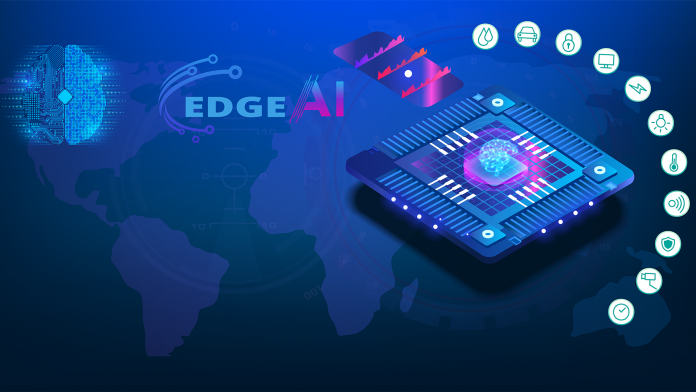Edge AI: Bringing Intelligence to the Edge

As the proliferation of connected devices and the demand for real-time processing continue to grow, Edge AI is emerging as a transformative technology. By integrating artificial intelligence (AI) directly into edge devices, Edge AI enables data processing and decision-making at the source of data generation, rather than relying on centralized cloud infrastructures. This paradigm shift promises significant improvements in speed, efficiency, security, and privacy across various applications and industries. In this blog, we explore the concept of Edge AI, its benefits, applications, and the challenges it faces.
Understanding Edge AI
Edge AI refers to the deployment of AI algorithms and models on edge devices, such as smartphones, IoT devices, autonomous vehicles, and industrial machines. These devices collect and process data locally, enabling them to make intelligent decisions without needing to send data to centralized cloud servers. This local processing capability is made possible by advancements in hardware, such as powerful microprocessors, GPUs, and specialized AI chips, as well as improvements in software frameworks and AI algorithms.
Key Benefits of Edge AI
- Reduced Latency By processing data at the edge, Edge AI eliminates the need for data to travel back and forth to cloud servers, significantly reducing latency. This is crucial for applications that require real-time or near-real-time responses, such as autonomous vehicles, industrial automation, and augmented reality (AR).
- Enhanced Privacy and Security Processing data locally on edge devices minimizes the need to transmit sensitive information over networks, reducing the risk of data breaches and cyberattacks. This enhanced privacy and security is particularly important in sectors like healthcare, finance, and smart homes, where sensitive personal information is handled.
- Lower Bandwidth Consumption Edge AI reduces the amount of data that needs to be transmitted to cloud servers, thereby lowering bandwidth consumption and associated costs. This is beneficial for applications in remote areas with limited connectivity or those that generate large volumes of data, such as video surveillance and industrial IoT.
- Improved Reliability Edge AI enhances the reliability of applications by reducing dependence on cloud infrastructure. In scenarios where connectivity is intermittent or unreliable, edge devices can continue to function and make decisions independently, ensuring uninterrupted service.
- Scalability Distributing AI processing across numerous edge devices alleviates the computational load on centralized cloud servers, enabling more scalable and efficient deployments. This is particularly advantageous for large-scale IoT networks and smart city initiatives.
Applications of Edge AI
- Autonomous Vehicles Autonomous vehicles rely on real-time processing of vast amounts of sensor data to make split-second decisions. Edge AI enables these vehicles to process data locally, improving response times and safety. For example, self-driving cars can analyze data from cameras, lidar, and radar sensors to detect obstacles, pedestrians, and other vehicles, making instant decisions to navigate safely.
- Smart Manufacturing In smart manufacturing, Edge AI is used for predictive maintenance, quality control, and process optimization. By analyzing data from sensors and machines in real-time, Edge AI can predict equipment failures before they occur, reduce downtime, and optimize production processes. This leads to increased efficiency, reduced costs, and improved product quality.
- Healthcare Edge AI applications in healthcare include remote patient monitoring, diagnostics, and personalized treatment plans. Wearable devices and medical sensors equipped with AI can analyze patient data in real-time, alerting healthcare providers to potential health issues and enabling timely interventions. For example, AI-powered devices can monitor vital signs, detect anomalies, and provide early warnings of conditions such as heart attacks or strokes.
- Smart Cities Smart city initiatives leverage Edge AI for traffic management, energy optimization, public safety, and environmental monitoring. For instance, traffic cameras and sensors equipped with AI can analyze traffic patterns in real-time, optimizing traffic light timings to reduce congestion and improve flow. Similarly, smart grids can use Edge AI to balance energy supply and demand, integrating renewable energy sources and reducing waste.
- Retail and Consumer Electronics Edge AI is transforming retail and consumer electronics by enhancing customer experiences and optimizing operations. In retail, AI-powered cameras and sensors can analyze shopper behavior, providing insights for personalized marketing and inventory management. Consumer electronics, such as smart home devices and wearables, use Edge AI for voice recognition, facial recognition, and personalized recommendations.
- Agriculture Precision agriculture benefits from Edge AI through real-time monitoring and decision-making. Sensors and drones equipped with AI can analyze soil conditions, crop health, and weather patterns, enabling farmers to optimize irrigation, fertilization, and pest control. This leads to increased yields, reduced resource usage, and sustainable farming practices.
Challenges of Edge AI
- Computational Constraints Edge devices typically have limited computational resources compared to cloud servers. Implementing complex AI models on these devices requires optimization techniques to ensure efficient processing without compromising performance.
- Energy Efficiency Edge devices often operate on battery power or have limited energy resources. Developing energy-efficient AI algorithms and hardware is crucial to prolong the operational life of these devices and ensure sustainability.
- Data Management Managing and processing large volumes of data locally can be challenging, especially in scenarios where data is continuously generated, such as video surveillance or industrial monitoring. Efficient data management strategies are needed to handle this influx of information.
- Interoperability Ensuring interoperability between different edge devices, platforms, and AI frameworks is essential for seamless integration and operation. Standardization efforts and open-source initiatives can help address this challenge.
- Security and Privacy While Edge AI enhances privacy by keeping data local, ensuring the security of edge devices and preventing unauthorized access is critical. Robust security measures, including encryption, authentication, and regular updates, are necessary to protect edge AI deployments.
Edge AI represents a significant advancement in the integration of artificial intelligence and IoT, bringing intelligence and decision-making capabilities directly to the edge of the network. By reducing latency, enhancing privacy and security, lowering bandwidth consumption, and improving reliability and scalability, Edge AI has the potential to revolutionize various industries. Despite the challenges it faces, ongoing advancements in hardware, software, and AI algorithms are paving the way for widespread adoption of Edge AI, unlocking new possibilities for innovation and efficiency in the digital age.
Stay ahead with ITBusinessNews – Your trusted source for Technology and Business news. Fast & Precise




